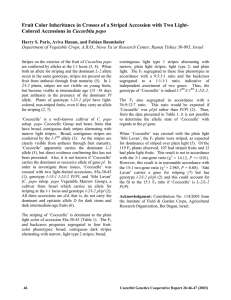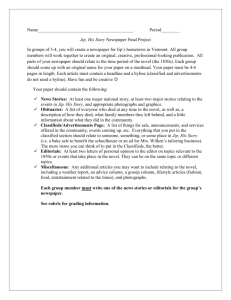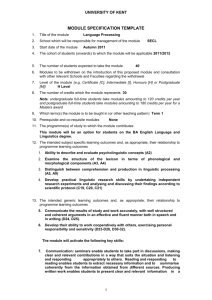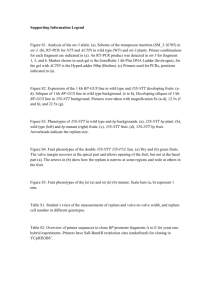Patterns of Broad Normal Striping in Egg Gourd Brent Loy
advertisement
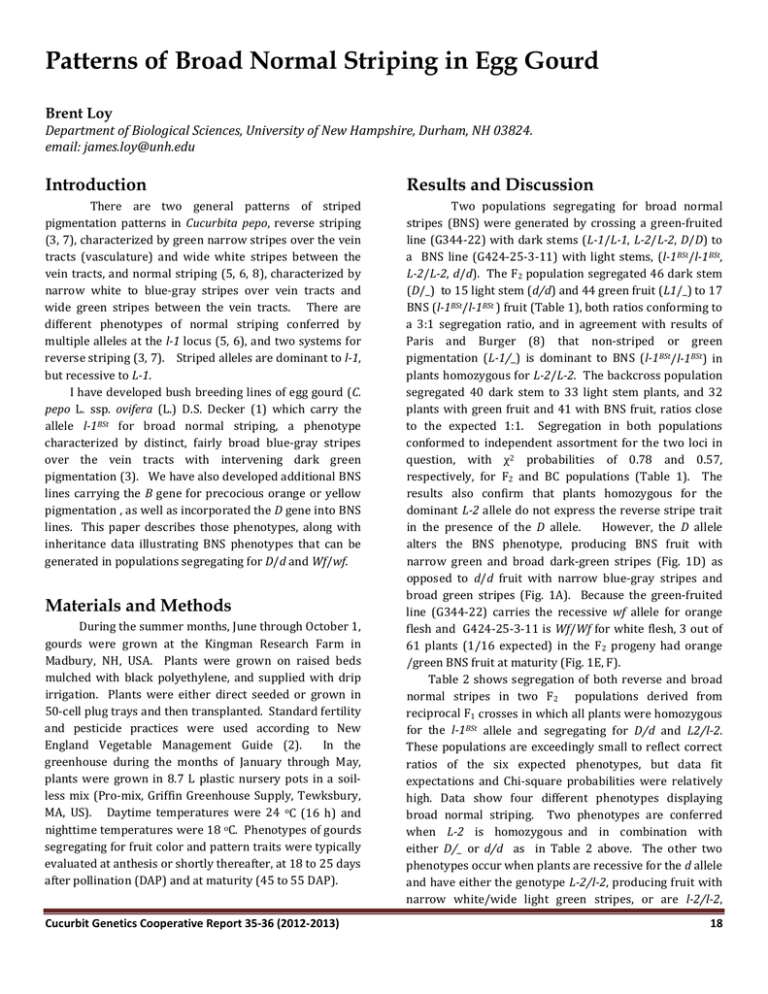
Patterns of Broad Normal Striping in Egg Gourd Brent Loy Department of Biological Sciences, University of New Hampshire, Durham, NH 03824. email: james.loy@unh.edu Introduction Results and Discussion There are two general patterns of striped pigmentation patterns in Cucurbita pepo, reverse striping (3, 7), characterized by green narrow stripes over the vein tracts (vasculature) and wide white stripes between the vein tracts, and normal striping (5, 6, 8), characterized by narrow white to blue-gray stripes over vein tracts and wide green stripes between the vein tracts. There are different phenotypes of normal striping conferred by multiple alleles at the l-1 locus (5, 6), and two systems for reverse striping (3, 7). Striped alleles are dominant to l-1, but recessive to L-1. I have developed bush breeding lines of egg gourd (C. pepo L. ssp. ovifera (L.) D.S. Decker (1) which carry the allele l-1BSt for broad normal striping, a phenotype characterized by distinct, fairly broad blue-gray stripes over the vein tracts with intervening dark green pigmentation (3). We have also developed additional BNS lines carrying the B gene for precocious orange or yellow pigmentation , as well as incorporated the D gene into BNS lines. This paper describes those phenotypes, along with inheritance data illustrating BNS phenotypes that can be generated in populations segregating for D/d and Wf/wf. Two populations segregating for broad normal stripes (BNS) were generated by crossing a green-fruited line (G344-22) with dark stems (L-1/L-1, L-2/L-2, D/D) to a BNS line (G424-25-3-11) with light stems, (l-1BSt/l-1BSt, L-2/L-2, d/d). The F2 population segregated 46 dark stem (D/_) to 15 light stem (d/d) and 44 green fruit (L1/_) to 17 BNS (l-1BSt/l-1BSt ) fruit (Table 1), both ratios conforming to a 3:1 segregation ratio, and in agreement with results of Paris and Burger (8) that non-striped or green pigmentation (L-1/_) is dominant to BNS (l-1BSt/l-1BSt) in plants homozygous for L-2/L-2. The backcross population segregated 40 dark stem to 33 light stem plants, and 32 plants with green fruit and 41 with BNS fruit, ratios close to the expected 1:1. Segregation in both populations conformed to independent assortment for the two loci in question, with χ2 probabilities of 0.78 and 0.57, respectively, for F2 and BC populations (Table 1). The results also confirm that plants homozygous for the dominant L-2 allele do not express the reverse stripe trait in the presence of the D allele. However, the D allele alters the BNS phenotype, producing BNS fruit with narrow green and broad dark-green stripes (Fig. 1D) as opposed to d/d fruit with narrow blue-gray stripes and broad green stripes (Fig. 1A). Because the green-fruited line (G344-22) carries the recessive wf allele for orange flesh and G424-25-3-11 is Wf/Wf for white flesh, 3 out of 61 plants (1/16 expected) in the F2 progeny had orange /green BNS fruit at maturity (Fig. 1E, F). Table 2 shows segregation of both reverse and broad normal stripes in two F2 populations derived from reciprocal F1 crosses in which all plants were homozygous for the l-1BSt allele and segregating for D/d and L2/l-2. These populations are exceedingly small to reflect correct ratios of the six expected phenotypes, but data fit expectations and Chi-square probabilities were relatively high. Data show four different phenotypes displaying broad normal striping. Two phenotypes are conferred when L-2 is homozygous and in combination with either D/_ or d/d as in Table 2 above. The other two phenotypes occur when plants are recessive for the d allele and have either the genotype L-2/l-2, producing fruit with narrow white/wide light green stripes, or are l-2/l-2, Materials and Methods During the summer months, June through October 1, gourds were grown at the Kingman Research Farm in Madbury, NH, USA. Plants were grown on raised beds mulched with black polyethylene, and supplied with drip irrigation. Plants were either direct seeded or grown in 50-cell plug trays and then transplanted. Standard fertility and pesticide practices were used according to New England Vegetable Management Guide (2). In the greenhouse during the months of January through May, plants were grown in 8.7 L plastic nursery pots in a soilless mix (Pro-mix, Griffin Greenhouse Supply, Tewksbury, MA, US). Daytime temperatures were 24 oC (16 h) and nighttime temperatures were 18 oC. Phenotypes of gourds segregating for fruit color and pattern traits were typically evaluated at anthesis or shortly thereafter, at 18 to 25 days after pollination (DAP) and at maturity (45 to 55 DAP). Cucurbit Genetics Cooperative Report 35-36 (2012-2013) 18 producing the wh/wh BNS fruit phenotype. In the latter phenotype, fruit appear white, but expression of homozygous l-1BSt alleles can be detected by slightly raised ridges over the vein tracts. Type 1 RS plants show the complete reverse stripe phenotype, narrow dark green stripes over the vein tracts and white pigmentation between vein tracts. In Type 2 RS, there are various degrees of mottled green and white pigmentation between the vein tracts. As shown in Table 1, when plants are homozygous for L-2, then plants with either genotypes L-1/l-1BSt or L-1/L-1 have dark green fruit, regardless of whether plants are D/_ or d/d as illustrated in Table 2, and no striping or at most very minimal striping is evident in any of the fruit. However, when the L-2 gene is heterozygous in plants carrying a D allele, some degree of intermediate reverse striping (some degree of green-white mottling between narrow dark green stripes) occurs regardless of whether L-1 is homozygous or heterozygous (L-1/l-1BSt), and the degree of white-green mottling varies with maturity of fruit. The B gene in combination with L-2 produces orange fruit (4), and when combined with BNS (l-1BSt), can produce attractive striped fruit. The range of phenotypes is further expanded by expression of genes which result in bicolor pigmentation patterns, whereby the B gene is expressed only in a portion of the fruit. Genes which affect the degree of expression of the B gene have been designated as Ep genes (9); the inheritance of these genes has not been determined in egg gourd. Figures 2A and 2B show a BNS breeding line (G14-2-1-10) homozygous for the B gene but segregating for white (WF/_) versus orange (wf/wf) flesh. When the Wf allele is present, stripping is white/yellow when B is expressed; when fruit is wf/wf, stripping is yellow/orange. Figure 2C shows a BNS egg gourd line with the B gene in combination with orange flesh and the D gene. Fruit with the D gene show darker yellow/orange and orange/green stripping than fruit which are d/d, in either B/_ or b/b backgrounds. Acknowledgement This work was supported by Hatch Grants from the New Hampshire Agricultural Experiment Station. Literature Cited 1. Decker, D.S. 1988. Origin, evolution, and systematics of Cucurbita pepo (Cucurbitaceae). Econ. Bot. 42:4-15. 2. Howell, J.C. 2006-2007. New England Vegetable Management Guide. Univ. Massachusetts Extension Office of Communication. 3. Loy, J.B. 2012. Introgression of genes conferring the bush habit of growth and variation in fruit rind color into white nest egg gourd, pp. 275-282. In: N. Sari, I. Solmaz, and V. Aras (eds.), Cucurbitaceae 2012 Proceedings, Adana, Turkey, Ҫukurova University. 4. Paris, H.S. 1988. Complementary genes for orange fruit flesh color in Cucurbita pepo. HortScience 23:601-603. 5. Paris, H.S. 2000). Gene for broad, contiguous dark stripes in cocozelle squash. Euphytica 115:191-196. 6. Paris, H.S. 2003. Genetic control of irregular striping, a new phenotype in Cucurbita pepo. Euphytica 129:119-126. 7. Paris, H.S. 2009. Genes for “reverse” fruit striping in squash (Cucurbita pepo L.). J. Hered. 371-379. 8. Paris, H.S. and Y. Burger. 1989. Complementary genes for fruit striping in summer squash. J. Hered. 80:490493. 9. Shifriss, O. and H.S. Paris. 1981. Identification of modifier genes affecting the extent of precocious fruit pigmentation in Cucurbita pepo L. J. Amer. Soc. Hort. Sci. 106:653-660. Table 1. Dihybrid segregation of progeny with either broad normal stripes (BNS), l-1BSt/l-1BSt) or green (L-1/_) fruit and with either light (d/d) or dark green (D/_) stem color. G07-1, F2, was derived from G424-25-3-11 (l-1BSt/l-1BSt, L-2/L-2 , d/d ) x G344-22 L-1/L-1, L-2/L-2, D/D ) , and G07-2 was derived from G424-25-3-11 (male parent) backcrossed to the above F1. Distribution of phenotypes Parental gr fr/dk stz gr fr/lt st BNS/dk st BNS/lt st G07-1 F2 35 9 12 5 G07-2 BC 17 15 23 18 _______ Expected ratio 9:3:3:1 1:1:1:1 χ2 1.09 1.99 P 0.78 0.57 zgr – green; dk st – dark stem; lt st = light stem; BNS/dk st = narrow green/wide dark-green stripes, dark stem; BNS/lt st = blue-gray narrow/wide green stripes, light stem. Cucurbit Genetics Cooperative Report 35-36 (2012-2013) 19 Table 2. Segregation of reverse and broad normal stripes in F2 populations derived from G424-25-3-11 x G12194-3 (G10-126) or its reciprocal (G10-110). Plants are homozygous for l-1BSt, but segregating for L-2/l-2 and D/d. Plants in the first three columns carry the D allele; plants in the last three columns are d/d. Parental G10-126 G10-110 G10-110 +126 Type 2 RS 35 22 57 Distribution of phenotypesz ____ Type 1 BNS BNS BNS BNS Expected RS gr/dk gr wh/lt gr gray/gr wh/wh Ratio 17 8 11 8 5 6:3:3:2:1:1 10 10 6 3 0 6:3:3:2:1:1 27 18 17 11 5 6:3:3:2:1:1 χ2 5.99 3.65 5.17 P 0.31 0.60 0.39 ZType 2 RS = narrow green /wide mottled gr/wh stripping; Type 1 RS = narrow green /wide white striping; BNS:gr/dk gr = green/dark green striped fruit, dark stem; BNS:wh/lt gr = white/light green striped fruit, light stem; BNS:gray/gr = blue-gray narrow stripes/wide green stripes, light stem; BNS: wh/wh = narrow white/wide off-white stripes, light stem. Figure 1. Illustrations and genotypes of different broad normal stripe (BNS) phenotypes. Cucurbit Genetics Cooperative Report 35-36 (2012-2013) 20 Figure 2. Interaction of the ‘B’ gene with the D/d alleles and Wf/wf alleles in pigmentation of mature striped egg gourds. Cucurbit Genetics Cooperative Report 35-36 (2012-2013) 21
